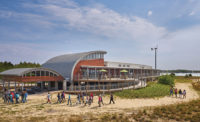“The holdup right now is that the codes in each state are different regarding gray water, and it would be very challenging to bring this product to market at this point,” says Nicolas Grohe, director of marketing and product development for Hansgrohe North America. While U.S. code authorities determine how clean recycled water needs to be, “There are no standards or codes in the U.S. now for what is gray water,” says Lars Christensen, Hansgrohe senior product manager. In the meantime, interested U.S. architects can specify the system for their European projects.
So how does the Pontos AquaCycle 2500 work? The fully automatic system uses a biomechanical treatment method, without any chemical additives, to transfer water that usually goes down the drain into water that can be reused for toilet flushing, cleaning buildings, or irrigation. First, a filter removes coarse particles from the incoming gray water, then the water undergoes a two-stage biological treatment, where a supply of atmospheric oxygen and microorganisms degrade contaminants in the water, such as soap and shampoo. The water is then disinfected through the use of a UV lamp and stored in the process water tank until reuse. Sediments generated during the biological treatment are automatically removed and conducted into the drains. If insufficient process water is available, the tank is initially filled with rainwater, and only when there is no rainwater available is it filled with drinking water. If too much water is generated, it is fed via an overflow pipe into the wastewater drain to prevent an overflow of the system. According to Grohe, it takes approximately four to eight hours for the wastewater to become reusable gray water.
The 2500 model, the latest in the line, is a combination of several other systems the company has been manufacturing since 2001. The system has been enhanced by the addition of a rainwater-harvesting system that helps supply water in case wastewater supply is low, and an advanced heat-recovery system that uses the gray water’s thermal energy to preheat incoming clean water, saving energy and expense. While Grohe says hotels, high-rise condominiums, and schools are the main markets, he sees potential in any project with enough showers, lavatories, and toilets. He cites one inspired application where a public pool in Yerres, France, recycles shower wastewater to supply water for the city’s street-cleaning trucks.
According to Grohe, AquaCycle is not intended to be moneymaker for the company, but it is something they felt compelled to invest in. “Although the product is not offered [yet in the U.S.], we want to talk about it and generate interest because we believe it’s the right thing to do.” Hansgrohe, Alpharetta, Ga. www.pontos-aquacycle.com
[Reader Service: April 2010 #200]




Post a comment to this article
Report Abusive Comment